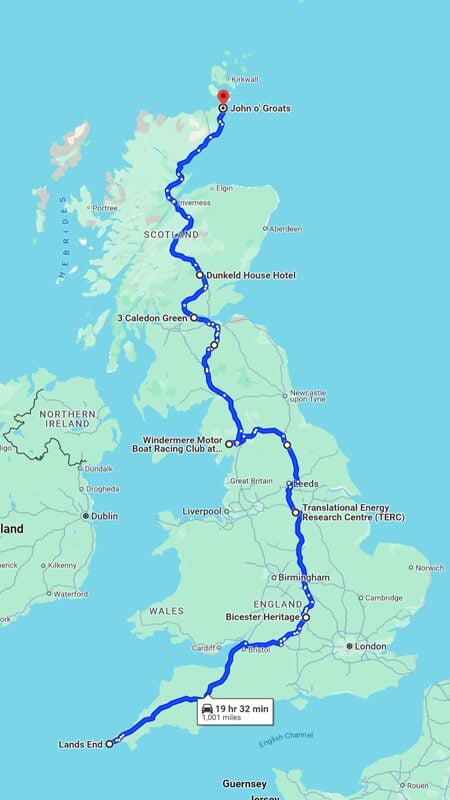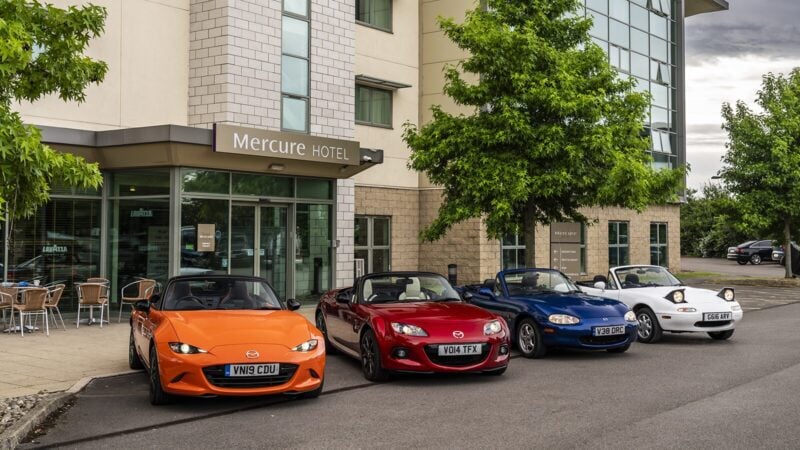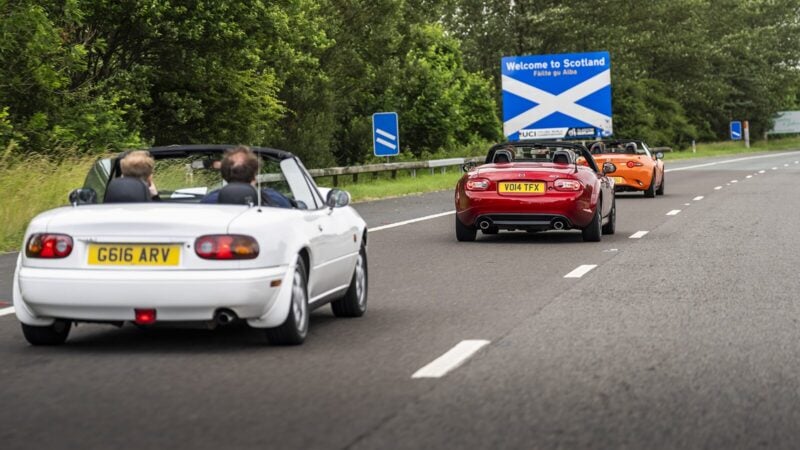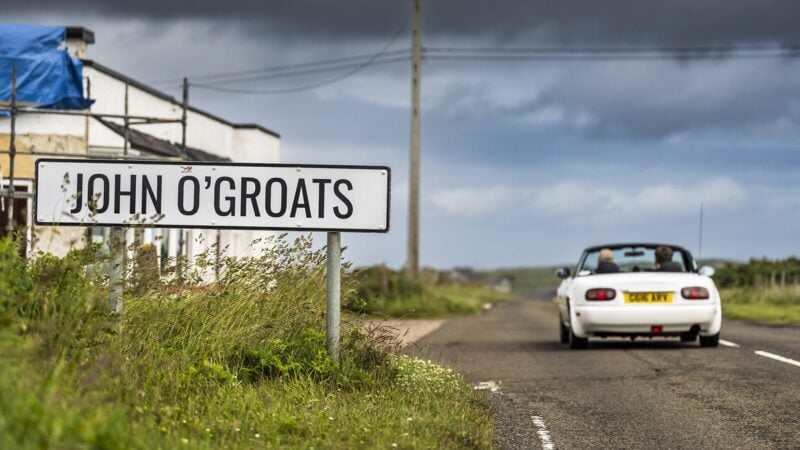
With everyday cars going electric, we’ve often wondered if it’s possible to still enjoy motoring’s past free of the associated guilt while the general public is weaned off fossil fuels. A 1,000-mile road trip in a range of classic (and future classic) cars shows that hobbyist driving won’t be confined to the history books.
Mazda UK invited us to take part in a journey along arguably the United Kingdom’s most famous long-distance trip, from Land’s End to John O’Groats, in a quartet of MX-5 models representing every generation. The twist? We’re running the whole thing without a single drop of fossil fuel in the tanks…
The Trip: Land’s End to John O’Groats
Those of you outside the United Kingdom might never have heard of the challenge, nor either of the places, but it’s one of the country’s oldest endurance feats — dating back 150 years.
In essence the journey takes you from the traditional furthest western point of the island of Great Britain, at Land’s End in England, to the north-eastern extremity at John O’Groats in Scotland. As a result, the journey is called “Land’s End to John O’Groats”, but often sensibly shortened to “LEJOG”.


It’s the longest possible straight line you can draw on the mainland, and without getting your feet wet it runs a direct distance by road of 837 miles. There isn’t actually a single agreed-upon route, as it was originally a walking challenge, and the nature of our trip necessitates some diversions too — with the usual route and ours highlighted on the maps above.
Lined up for the journey are four generations of Mazda MX-5. We’ve got a choice of a white, early Mk1 (NA), the highly desired Tenth Anniversary Mk2 (NB), a power-retractable hardtop Mk3 (NC) in 25th Anniversary guise, and the exact bright orange 30th Anniversary Mk4 (ND) we drove when the car was launched. With four teams of drivers we’d swap cars at the end of each leg, as well as switching seats en route.

First Leg: Land’s End to Bicester
Land’s End is pretty remote by the UK’s standards. Standing on the shore and looking due west you have an unobstructed view of more than 2,000 miles; the next landfall is Coachman’s Cove in Newfoundland.
Although the waters here are technically the Celtic Sea, it’s basically the eastern shallows of the Atlantic Ocean, and that meant that the lovely sunshine we had on the previous evening gave way to thick, early morning fog. Ideal convertible weather, really.
It’s been some time since I’ve driven an NB, so we picked the blue machine first for the trek back to civilization and a first chance to sample the “Sustain” fuel in the tank — and we weren’t quite sure what to expect.

As a short primer, Sustain is described by its manufacturer, Coryton Fuels, as a “second-generation” biofuel. In essence, that means it’s not derived from crops grown specifically for the purposes of making fuel — taking farmland away from food production — but from waste material from various sources. That does include farming, though it’s by way of items that are rejected or unsuitable for human consumption or even animal feed.
The first question then would be whether there’s any notable difference in the car’s driving manners, including power delivery and fuel economy. As I said it’s been a while since I drove an NB, but aside from the six-speed box of the 10AE the package is barely changed from my own NA at home. From what I could tell, it felt indistinguishable from running a tank of super unleaded (98RON, equivalent to Premium) through.
On the winding roads through Cornwall, onto the main roads and finally the motorway network at Exeter, the NB seemed perfectly fine with a tank of Sustain and the fuel economy appeared broadly in line with what my experience says an MX-5 of this age can achieve. That’s handy as the trip to Bicester would take us 283 miles, giving a little margin for error (and higher speeds) but not much.

Second Leg: Bicester to Sheffield
Our MX-5s met Bicester (pronounced “Bister”, for reference) at lunch time, and while it’s perhaps not the best-known place outside the UK it’s well known in classic car circles here. That’s because it’s the base of more than 50 specialist motoring organizations and companies on the Bicester Heritage site.
For our purposes this includes Motor Spirit, where we can get a vital top-up of our unique fuel due to the fact there’s a public-facing pump for Sustain here. However the sprawling site also includes everything from the UK headquarters for the Polestar brand to experts who’ll rebuild your historic car.

That neatly brings us onto our second important point with Sustain: ethanol. It’s a bit of a dirty word around classic cars because it doesn’t play well with the materials in some older fuel systems. A high ethanol content — such as the 10% blend now appearing in regular “E10” pump fuel in the UK — can cause problems for these vehicles, but Sustain Classic like we’re using here is less than 1% ethanol.
With all four cars topped up, we’re switching to the NC for the second drive of the day which will take us up to Sheffield another 125 miles north and finish off the longest single day of driving.
It’s a bit of a dull motorway trek — made worse by dozens of miles of roadworks and a 50mph limit enforced by average speed cameras — and that’s part of why we’ve moved to the third-gen car. While it’s my least-favorite of the four, it is the most-suited to this kind of work.

We’re not just heading there because it’s my hometown, or because it’s roughly in the middle of our journey, but because we’re going to take a little top-up at a facility called the Translational Energy Research Centre (TERC) based on the apron of the former Sheffield City Airport.
Although that sounds a bit like something from Stargate, TERC is part of the University of Sheffield and researches and develops zero-carbon energy. One of its partners is Coryton, with which it manufactures jet fuel out of thin air.
Literally: the OXCCU reactor at TERC combines atmospheric carbon dioxide with hydrogen to make hydrocarbons suitable for jet fuel. A bit much for our MX-5s, but we have some more Sustain in the tanks as they settle in for a well-earned overnight rest.

Third Leg: Sheffield to Windermere
By any measure, the Lake District isn’t exactly on the LEJOG route, but we’re taking a bit of a diversion for another fuel stop. As you might have figured, these specialized fuels are not exactly available at the pump and — limited by the older MX-5s’ approximate 300-mile range — our route is planned to visit places we can pick it up.
That brings us on to a second sticking point: not only is the fuel not widely available, it’s kind of expensive. This shouldn’t be any surprise, as it’s a largely new product and there’s currently no pressure at all to adopt it while everyone’s paying attention only to the new vehicle parc and you can still get unleaded every two miles across the whole country.

We’re actually using a special 100% fossil fuel-free blend that isn’t commercially available, but if you want to top up with the least amount of dinosaur juice (Classic Super 80) it’ll cost you around three times as much as ordinary pump gas, itself already pretty expensive in the UK. A tank on one of these MX-5s works out at — are you sitting down? — £230 ($300).
If you think that’s steep, wait until you find out why we’re going to the UK’s most famous lake (okay, “mere”), Windermere. This former site of famous and infamous world water speed record attempts is home to the Windermere Motor Boat Racing Club and I think by now you can guess what they put in their tanks.

Yes, the club now uses a marine motorsport blend of Sustain fuel for its fleet, including the rather neat purple F2 machine you’ll see in the pictures. Again, it’s a little more than the MX-5s need, but a quick brim with the fuel we need and a switch up to the ND sees us heading off in the direction of Scotland.
Fourth Leg: Windermere to Dunkeld
This is another monster leg of over 220 miles, but most of the motorway business is done and dusted. A nicely staged shot as we cross the border into Scotland — it’s an English/Scottish thing — is almost the last of it before we buzz across to the east.

The longer leg gives us a chance to reflect on biofuels in general, what makes them Sustain-able, and why their adoption is on the slower side — especially as we’re zipping through and between forests at this point.
In essence, any car burning hydrocarbon-based fuel to make power emits carbon dioxide from the tailpipe. That goes for whatever fuel you put in it, and that includes the sustainable fuel. Carbon dioxide still comes out and still goes into the atmosphere, and that’s pretty much all anyone cares about measuring.
However, fuels made from plants that are growing now don’t significantly add to the carbon dioxide in the atmosphere when burned. They sequester carbon to grow and it’s released back when made into fuel. That’s the difference from digging for oil from the trees that sucked up carbon 300 million years ago and burning that, re-releasing it after all that time underground.

It’s not just about fuel either, as another diversion to a unique facility on the banks of the famous Firth of Forth shows. The Celtic Renewables refinery — where we’re also taking on a little more fuel — is using biochemical processes to create a sustainable source of important chemicals used in all aspects of vehicle manufacture.
Known as “ABE”, the process creates acetone, butanol, and ethanol from waste products like potatoes that are unfit for consumption and spent grain (or “draff”) from whisky distillation; we are in Scotland now after all. These chemicals go into all sorts of automotive products, including all the electronics, paints and lacquers, and hydraulic fluids, as well as fuels.
From there it’s just a short run up to our final overnight stop in Dunkeld, the “Gateway to the Highlands”, for the last, uninterrupted stretch to the finish line.

Fifth Leg: Dunkeld to John O’Groats
Of course we’ve only got the one car left now, and we can’t think of a much better way of driving up the extremely scenic and largely engaging roads to the top of the country than the Mk1 NA.
It’s the oldest and least powerful car here — with a 115hp, 1.6-liter engine — so really represents the best use case for the classic car-focused fuel. I’ve driven Mk1s for years, so it was a pretty familiar feeling to get back behind the wheel, even if my colleague found the heaters insufficient for dealing with the Scottish chills at 60mph.
If anything was going to show a shortcoming in the Sustain fuel, it would be this but again the car may as well have been running a tank of super unleaded. The top of Scotland seems to go on for ever — even more than Cornwall did on the first day — and there’s plenty of climbing to tax the old Mazda’s relatively weedy engine, but I could barely tell a difference from my own later 1.8 model.

2024 marks the 35th anniversary of the Mazda MX-5, and it’s fair to say that not a single one of these four cars missed a beat across the week. One covered pretty much 10% of its entire mileage to date over the three-day drive.
Despite a couple of refreshment stops for the flagging drivers, we came into John O’Groats just after lunchtime to complete the trip — which was also the only entirely fossil-fuel free LEJOG accomplished by a combustion-engined car.
That’s a key takeaway here too. Fuel of this kind will help reduce the CO2 burden from the millions of combustion-engined vehicles still on the roads even once (or if) electric vehicles become the only new cars available, and the only way to enjoy classic and hobbyist motoring without expensive and divisive conversion to electric power.

Epilogue
With the 1000-mile trek complete and all the photographs we could pose for in the driving rain taken, we returned the four MX-5s 20 miles down the road to Wick Airport so that most of the attendees could fly home.
That meant collecting the vehicles on a transporter to take them back to headquarters and, just to gild the lily, this truck was also full of a Coryton Sustain fuel — as were two CX-60 support vehicles standing by just in case.
As for me, I live in a strange part of the country — neither local enough nor far enough away — where returning by train or plane wasn’t entirely possible on the same day so I drove the 400 miles back.
In a Sustain-fueled CX-60…
Images via Mazda UK/David Smith
See more articles on Mazda.









